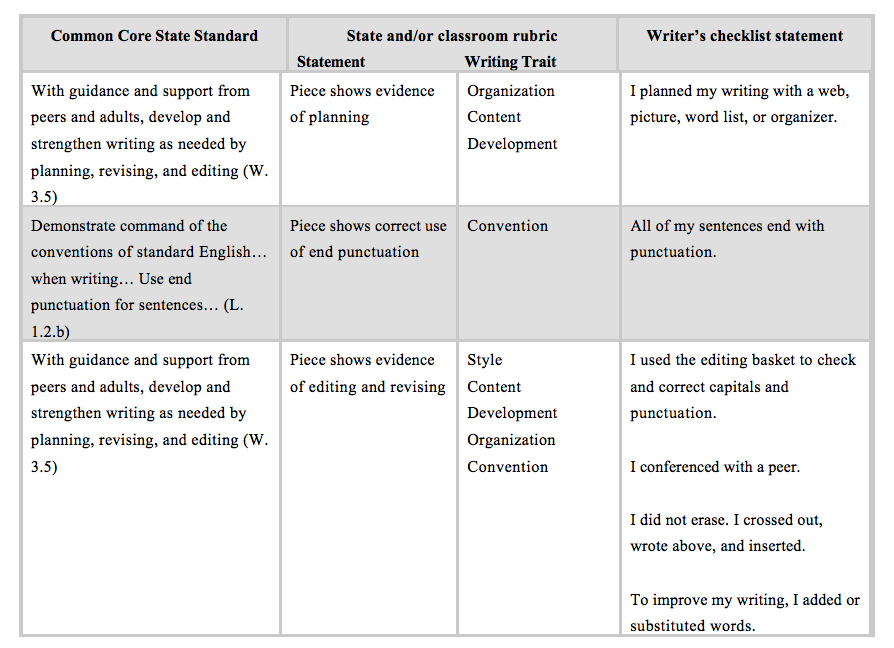 No solution can ever be found by running in three different directions. - Deepak Chopra “Three is a magic number.” That’s what the song says and I think it is true. Consider just a few of the many trios I’ve taught in elementary schools over the years: evaporation, condensation, and precipitation (water cycle); igneous, metamorphic, and sedimentary (rock types); adjectives, nouns, and verbs (parts of speech); and, solid, liquid, and gas (states of matter). This year, I have been teaching another trio: the standard, the rubric, and the checklist. Ranging from a multi-paged manuscript to a one-page list, at first glace the three seem to be dramatically different documents. Yet each states the same foundational information – what it takes to be a skillful writer. When properly constructed, schools can harness the three to pull in one direction, thereby intensifying the effectiveness of teacher instruction and increasing the achievement (and feelings of success) of student writers. The Standard At the elementary level, the Common Core writing standards are an interrelated series of ten anchor statements that define an inseparable whole: skillful writing. Intimately connected to the writing standards are the language standards. Finally, when viewed through the lens of writing, the Common Core reading standards can be used to teach about writing. So there are many standards to consider. But they all point to one fundamental goal: students writing skillfully. Although each standard increases in sophistication as it runs through multiple grade levels, each retains its essence. Thus, it should be relatively easy for schools to coordinate writing instruction across grade levels via the standards, and via the rubrics and checklists developed from those standards. The Rubric Rubrics for writing populate the web like daisies in a field. However, I suggest that individuals or grade level teams create rubrics that best fit their program, flexibly incorporating skills and concepts throughout the year, differentiating based on student need. Also important are the state-level rubrics designed to help students maximize their scores on high stakes tests. Many of these rubrics explicitly incorporate conventions (such as grammar and spelling) and traits (such as focus and organization) into the three types of writing most commonly mentioned in the standards – narrative, opinion, and informational. See, I told you three was a magic number! Whether state generated or teacher created, writing rubrics should flow from the skills and concepts put forth in the standards, and mirror the statements found on a writing checklist. The Checklist The writing checklist puts writing into the hands of the learner, moving it from a teacher-directed activity to a student-directed one. Also, the checklist doubles as a formative assessment tool, capable of capturing all manner of writing nuance. When students use it accurately and consistently, all the teacher need do is look at unchecked skill statements to identify possible areas of improvement. Like rubrics, checklists are easily found on the web. However, I suggest that teachers create a master checklist that is saved as a table in an electronic document. A master list enables teachers across content areas and grade levels to have a common point of reference. When the document is digital, lists can be easily and quickly tailored to match the achievement level of students, which change over the course of time. Whether pulled from the web or generated internally, a checklist should parallel the writing rubric and the Common Core standards. Figure 1 shows the parallel arrangement of a 3rd grade standard, rubric, and checklist. Creating rubrics and checklists that incorporate Common Core writing skills and concepts, and making sure these tools are present across content, classrooms, and grade levels, gives student writers many chances to practice writing throughout the year, in varying subject areas, and across the grade levels. And when documents are aligned, teachers automatically assess progress towards the standards as they apply the rubric and fine-tune the checklists. Additionally, through document alignment, teachers come to understand the essentials of writing. And as they repeatedly look at the standards and rubrics and checklists (oh my!), they begin to form instructional habits rooted in the essentials. Forming effective instructional habits is crucial to teaching. Why? Busy teachers simply don’t have time to carefully and intentionally think through every instructional action. When a teacher works with 20 squirming first graders or 25 chattering fifth graders for hours on end, she is often responding to the demands of the moment. In teaching, it is easy to be pulled from what is most important or forget what is most effective. So it behooves schools to identify effective instructional techniques, like the intentional use of writing language, or the explicit teaching of genre organization, and work them into writing programs. This gives teachers multiple opportunities to practice the techniques to the point where they begin to use them habitually, efficiently, and fluently. There are many reasons to make sure that writing standards, writing rubrics, and writing checklists mirror one another, but the most important reasons are that alignment leads to more powerful teaching, which then leads to greater student achievement. When three come together as one, the one can be formidable. For a free download of "Rubric Construction Tips", go to the File Cabinet tab |
Mark WeaklandI am a teacher, literacy consultant, author, musician, nature lover, and life long learner.
|
 RSS Feed
RSS Feed